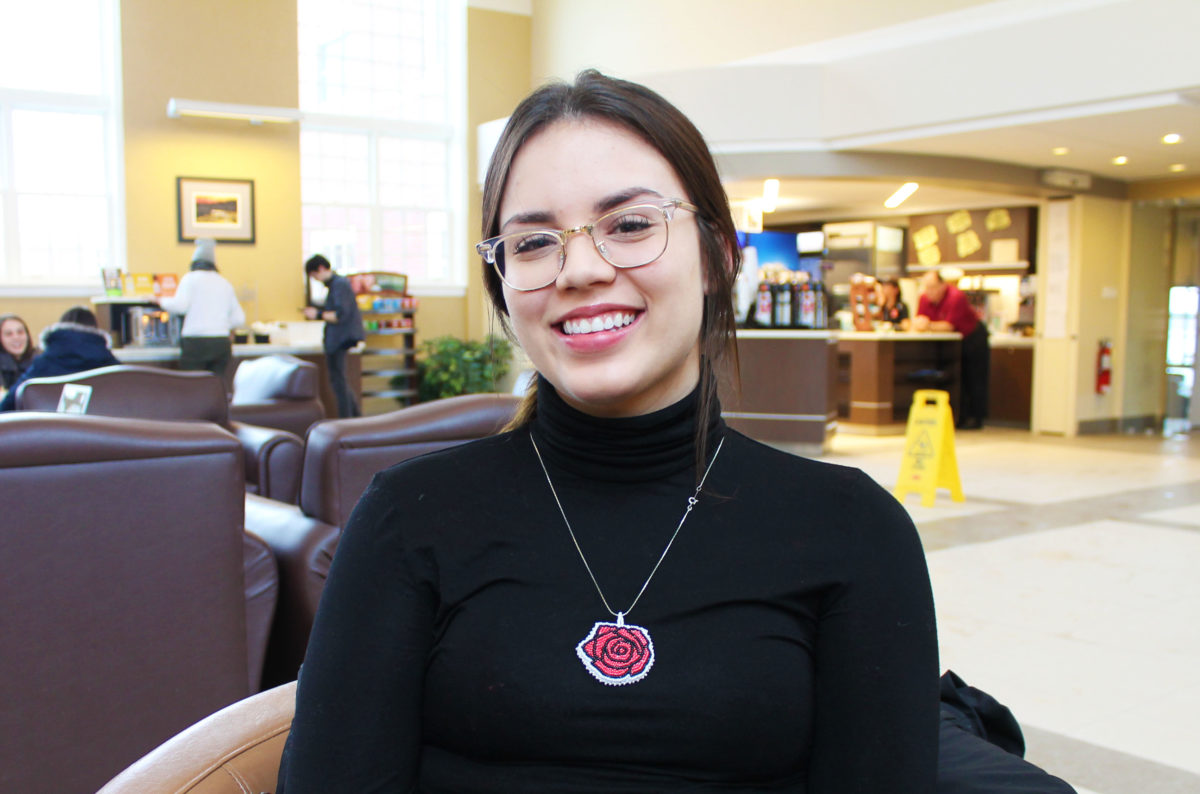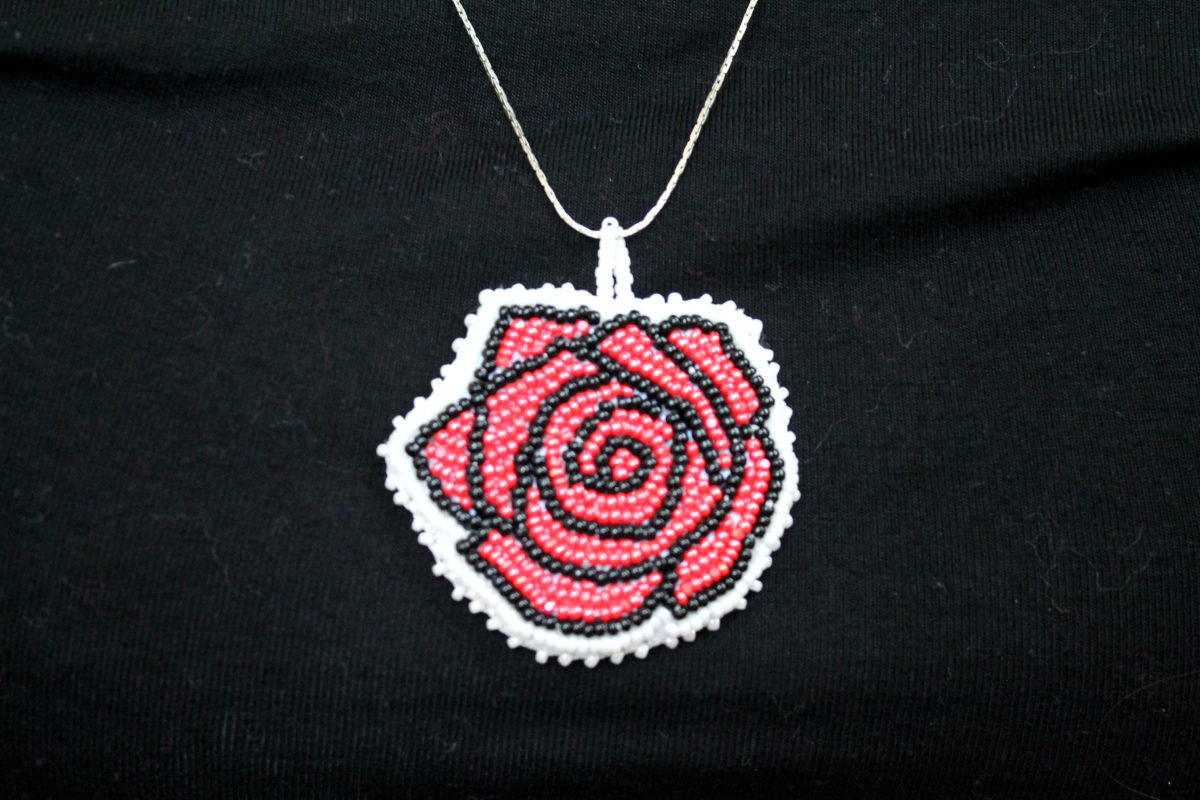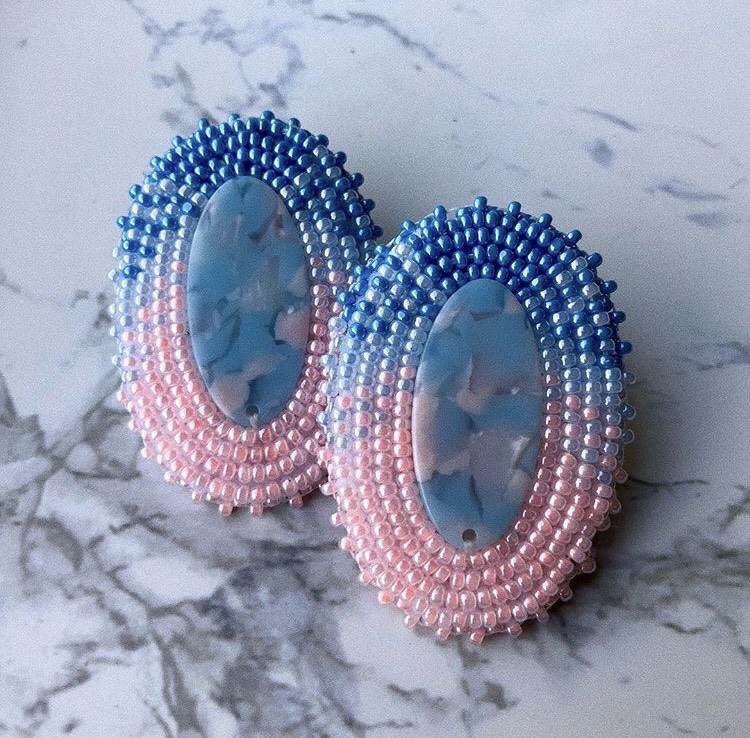
In her free time, fourth-year communications student Alexa Metallic strings small, colourful beads together to form earrings, pendants and pins. She spends hours every weekend on the meticulous art, laying down one bead at a time.
“The spare time that I do have, I spend beading,” said Metallic.
As a child, Metallic was taught how to do beadwork by her aunt. She stopped practicing for years but picked it back up in summer 2018. She has an Instagram page where she sells her creations.
Now she’s making pins to raise money in awareness for missing and murdered Indigenous women and girls.
“I kind of got inspiration for the pin project I’m starting up just trying to combine beadwork with advocacy in some capacity.”
The pin is in the shape of a girl with long hair made of delicate ebony beads flowing down her back. Her scarlet red dress with two rows of ivory beads represents a red shawl, a symbol associated with missing and murdered Indigenous women and girls. Shiny gold beads outline the entire pin as if it’s glowing.

“In Canada, there’s a disproportionate amount of violence against Indigenous women and girls. I’ve decided to create these pins to honour our stolen sisters, as well as spread awareness of this growing epidemic (that has yet to be properly addressed),” Metallic wrote in a Facebook post.
Metallic’s mother and grandmother inspired her to make the pin. They once bicycled across Canada to raise awareness for violence against women.
“I’ve always aspired to make a change for the same reason, but obviously I’m not fit enough to cycle across Canada.”
Getting started on the pin wasn’t easy. Metallic said she’s not the best at drawing, so designing the pin was a struggle for her.
“I’m a little bit of a perfectionist so it was really hard for me to be able to draw this out. It took me forever to draw it out.”
Transitioning from creating earrings and pendants to creating a pin was also a learning curve for Metallic.
“I kept taking it apart, putting it back together, and I’ve never used a pin before. I’m used to using earring backs, so for me to figure out how to use the pin, it was hard.”
Each pin, which takes at least 10 hours to complete, is $65. Metallic is donating 15 per cent of the funds from each pin to the Native Women’s Association of Canada. She’s already received more than 20 orders.

Getting inspiration
But it wasn’t money or jewelry that inspired her to start beading again. It was creating regalia dresses, which are worn during Powwows and other ceremonies, that encouraged her to pick it back up. Regalias are not all made the same, as different regalias are associated with different dances.
“Ultimately, my goal for it is to be able to create my own regalia pieces from that. That’s why I initially started again, it wasn’t really to make earrings or to make money or anything like that. It was to re-teach myself to be able to make those pieces for my regalia, for my little sister, for my nieces.”
As a full-time student with an internship, Metallic has little free time to work on her pieces. On the weekends, she spends at least 12 hours beading.
“If I stay in on the weeknights or if I get a class cancelled, any opportunity I could have to [do beadwork], I will.”
When Metallic does find time to bead, she makes sure she’s in the right headspace before beginning.
“My aunt taught me that you shouldn’t bead if you’re in a bad headspace because you’re putting that energy into that beadwork. So even if I really wanted to, if I’m in a bad headspace, I just won’t do it.”
Metallic gets inspiration for new pieces from everything around her like different colour schemes, flowers and other artists’ creations.
“One time I was looking at, this sounds corny, but the sunset. It was pink and purple and I liked the way the colours blended.”
She created a pair of pink, purple and blue earrings inspired by the sight.
Though Metallic sometimes gets inspiration from other artists, she emphasizes the importance of asking permission before using designs.

Finding materials
When Metallic picked up beading again, she had trouble finding beads at local craft stores like Michaels. Now she buys materials at powwows or from Sophia’s Creative Spirit near her hometown of Mi’gmaq First Nation in Quebec. If she doesn’t buy them there, she orders them online, but sometimes the sizing and colour can be off.
Materials aren’t cheap, and Metallic believes people often seek out cheaper products from non-Indigenous artists, but the beading materials and methods often aren’t the same.
“You should want to buy authentic Indigenous art. You should want to support artists.”
Although school and work are busy, Metallic has learned a lot about beading and her culture through her work.
“I enjoy it because it is a learning process, I’ve been able to learn a lot.”
